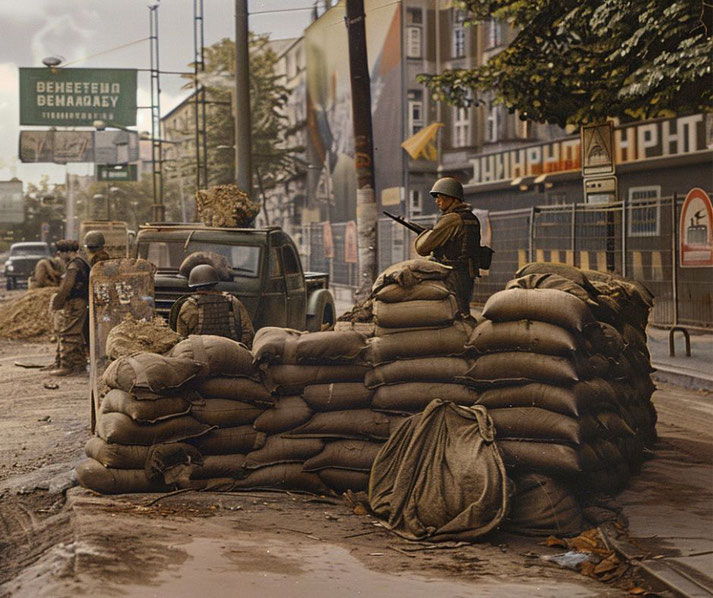The Berlin Blockade and Airlift: How Soviet Russia tried to starve Europe into submission

In the years that followed World War Two, there was growing tension between Soviet Russia and the democratic states in Europe, and the city of Berlin in Germany became an economic battleground.
In an 11-month period between 1948-9, the Soviets would attempt to block western access to the city in order to control it. This blockade would become a key event in the early Cold War era.
The blockade was a response to the Western Allies' currency reform, which the Soviet Union saw as a move towards creating a separate, capitalist West German state.
The United States and its allies believed that West Germany should be a single, unified country. They were worried that if East Germany became independent, it would strengthen Soviet influence in Europe.
This event showed the conflict between capitalist and communist ideologies in the post-war world.
The post-war tensions between east and west
Ideological differences between the capitalist West and communist Russia were at the heart of the event.
The conferences at Potsdam (July 1945) and Yalta had decided the future of Germany.
At them, the allies had agreed that Germany would be divided into four zones, with each country occupying a zone.
Berlin, which was located in the Soviet zone, was also to be divided into four sectors.
Bizonia was the name given to the combined American and British occupation zones in Germany after they merged on the 1st of January 1947. Later, the French zone was added and it became known as Trizonia.
This angered the Soviets who saw it as a move towards a unified Germany. Then, the United States had developed the Marshall Plan to help European countries recover from the war.
It gave economic aid to countries that agreed to democratic governments and free trade.
The Soviet Union saw this as an attempt to stop the spread of communism and they refused to participate in the plan.
Enraged by the previous decisions made by the Allied forces, the Soviets decided to attempt to forcefully exert their control over Berlin.
In 1948, they announced that East Germany would become an independent state.
This move shocked the United States and its allies, as they saw it as an attempt by Russia to expand its influence in Europe.
How the blockade and airlift began
The Berlin Blockade began on June 24, 1948, when the Soviet Union started to restrict traffic between West and East Germany.
They did this by blocking all road, rail, and canal links into West Berlin.
The blockade had several effects on the two and a half million people who lived in Berlin. Firstly, it caused food and fuel shortages.
This led to rationing and long queues for basic necessities. Secondly, it made life very difficult for those who needed to travel between East and West Berlin.
In order to break the blockade, the United States and its allies organized a massive airlift of supplies into West Berlin.
Planes flew into Tempelhof Airport in West Berlin around the clock. At the height of the airlift, it was estimated that one plane landed every 45 seconds at Tempelhof Airport, as well at Gatow and Tegel, the latter of which was constructed specifically to accommodate the increased air traffic of the Berlin Airlift.

End of the blockade
The blockade continued until May 12, 1949. On this day, the Soviet Union finally lifted the blockade.
This was done after it had become clear that the United States and its allies were not going to back down.
Ultimately, the blockade had continued for 11 months. During this time, more than 200,000 flights delivered approximately 2.3 million tons of supplies, including food, fuel, and medicine, to isolated West Berlin.
The cost of this operation was estimated at $12 billion (in today's money).
Why was this event so significant?
The Berlin Blockade was a significant event in the Cold War era because it highlighted the tension between the two sides and demonstrated America's commitment to defending its values.
After the end of the blockade, the creation of two separate German states eventually followed, with the Federal Republic of Germany (West Germany) and the German Democratic Republic (East Germany) being established in 1949.
The blockade and the subsequent airlift also showed the determination of both the Western Allies and the Soviet Union to maintain their respective spheres of influence in Europe.
Importantly, the successful circumvention of the blockade through the airlift significantly bolstered Western prestige and contributed to the eventual formation of NATO in April 1949, as Western nations sought to strengthen their defense against potential Soviet aggression.
In the years following the Berlin Blockade, the tensions between the East and West continued to escalate, leading to events such as the construction of the Berlin Wall in 1961 and the Cuban Missile Crisis in 1962.
The Berlin Blockade and Airlift was an early example of the proxy conflicts and brinkmanship that would become a central feature for the rest of the Cold War.
What do you need help with?
Download ready-to-use digital learning resources
Copyright © History Skills 2014-2025.
Contact via email
With the exception of links to external sites, some historical sources and extracts from specific publications, all content on this website is copyrighted by History Skills. This content may not be copied, republished or redistributed without written permission from the website creator. Please use the Contact page to obtain relevant permission.





